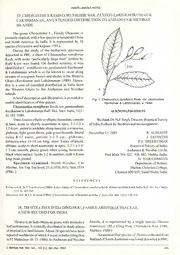
Thottea Paucifida Ding Hou, Family Aristolochiaceae, a new Record for India PDF
Preview Thottea Paucifida Ding Hou, Family Aristolochiaceae, a new Record for India
MISCELLANEOUS NOTES CHIONANTHUSRAMIFLORUSROXB. VAR. PENINSULARISRAVIKUMAR& 37. LAKSHMANAN, AN EXTENDED DISTRIBUTION TO ANDAMAN &NICOBAR ISLANDS The genus Chionanthus L., Family Oleaceae, is primarilytropical,withafewspeciesintemperateChina and North America. In India, it is represented by 10 species (Srivastava and Kapoor 1991). During the study of the herbarium specimens deposited in PBL, a sheet of Chionanthus ramiflorus Roxb. with notes "‘partieciItirly large fruit” written by Ruth Kiew was found. On further scrutiny, it was identifiedasC. ramiflorusvar.peninsularis Ravikumar & Lakshmanan which is so far known to occur along streams ofevergreen forests and sholas in the Western Ghats (Ravikumar and Lakshmanan 1989). Flence, this is a case of extended distribution in India from the Western Ghats to the Andaman and Nicobar Islands. A briefdescription and illustration is provided to Fig. 1: Chionanthus ramiflorus Roxb. var. peninsularis enable identification ofthisspecies. Ravikumar & Lakshmanan, a. Habit Chionanthusramiflorus Roxb. var.peninsularis Ravikumaret Lakshmanan Bull. Bot. Surv. India, 31(1- ACKNOWLEDGEMENT 4): 163. 1989. Trees. Leavesellipticorelliptic-lanceolate,cuneate WethankDr.N.P. Singh,Director, Botanical Survey at base, acute or shortly acuminate at apex, 2.5-1.3 x ofIndia,Kolkataforfacilitiesand encouragement. .2-6cm., entireto undulatealongmargins,coriaceous, 1 glabrous, light green above, pale green beneath; lateral November 15, 2001 R. SUMATH1 veins 8-12 pairs; petiole 1-3.5 cm., glabrous. J. JAYANTHI Infructescence 11-14 cm long, stout. Fruits ellipsoid, P.V. SREEKUMAR oblique, acute to short acuminate at apex, 3-3.5 x 1.4- Botanical Survey ofIndia, 1.7 cm, smooth, glossy green when young, brownish- Andaman & Nicobar Circle, mm blackwhen mature. Seeds 1-2 in number; stalk4-8 Port Blair 744 102, P.B. 602, Haddo, India. NARASIMHAN long,stout,jointed. D. Specimen examined: North Nicobar, Car Department ofBotany, Nicobar,TeeTop, Sea level,25.ii.1976,N.G.Nair3534 MadrasChristian College, (PBL ). Chennai 600059, Tamil Nadu, India. REFERENCES Ravikumar,K..&V. Lakshmanan(1989):AnewvarietyofChionanthusramiflorusRoxb.(Oleaceae) fromSouthIndia.Bull Bot Surv India 31(1-4): 163-165. Srivastava,S.K.& S.L. Kapoor(1991): ChionanthusLinn.(Oleaceae) in India.J. Econ. Tax. Bot 15(1): 129-141 38. THOTTEA PAUCIFIDA DING HOU, FAMILY ARISTOLOCHIACEAE, ANEW RECORD FOR INDIA Thotteaisan Indo-Malayangenuswith distinctive Islands, it is represented by a single species Thottea leafarchitecture. It ischieflydistributed in shadyplaces tomentosa (Bl.) Ding Hou. (Vasudeva Rao 1986, oftropical low land forests. About26 specieshavebeen Mathew 1988.) reportedworldwideofwhich4occurin India(DingHou An unidentified speciesofThotteacollected from in FI. Malesiana 10: 73. 1984). In Andaman andNicobar RutlandofSouth Andamanwasfounddeposited in PBL. J. Bombay Nat. Hist. Soc., 101 (1), Jan.-Apr. 2004 195 MISCELLANEOUS NOTES This species is reported for the first time in India from the Andaman and Nicobar Islands. A brief description and illustration is provided for identification. Thottea paucifida Ding Hou, Blumea 27: 324. 1981; FloraMalesiana 10: 73. 1984. Undershrubs. Leavesalternatecoriaceous,elliptic to slightlyobovate,4-10 x2-4.5 cm, cuneate, obtuseto slightly cordate at base, margin entire, apex acute to obtuse, densely villous below, glabrous above. Basal nerves 3; lateral nerves 4-5 pairs, elevated below, mm reticulate, obscure above. Petiole c. 3.5 long, angular, twisted at apex, glabrous. Seeds ellipsoid, c. 3 x 1.5 mm, transversely rugose. Note: Ding Hou in his revision states “Capsules Unknown”. Capsules and seeds are described here for the firsttime. Specimen examined: South Andaman, Rutland, 19.vii.1986. J.L. Ellis, 12305 (PBL). ACKNOWLEDGEMENT We thank Dr. N.P. Singh, Director, Botanical SurveyofIndia, Kolkata forprovidingencouragement andfacilities. Fig. 1: Thottea paucifida, A. Habit, B. Twig with capsule, June 8, 2002 R. SUMATHI VINOD MAINA C. Seed LAKRA G.S. The species was later identified as Thottea paucifida Botanical SurveyofIndia, Ding Hou; earlier know to occur in Borneo. Ding Hou Andaman &NicobarCircle, in his revision ofFamily Aristolochiaceae statesthat it P.B. 602, Haddo, hasbeen collectedjustonce fromthebanksofastream PortBlair744 102, flowingthrough stands ofRubber and othertrees. India. REFERENCES Mathew, S.P. (1988): A supplementary report on the flora and Vasudeva Rao, M.K. (1986): A preliminary report on the vegetation ofBay Islands, India. J. Econ. Tax. Bot. 22(2): angiosperms ofAndaman & Nicobar Islands. J. Econ. Tax. 249-272. Bot. 8(1): 107-184. 39. JUNCUSSPUMOSUSNOLTIE (JUNCACEAE), A NEW RECORD FOR INDIA During plant exploration in Dibang Valley, 2904 - CAL) Arunachal Pradesh, wecollected an interestingspecies Juncus spumosus Noltie in Edinburg J. Bot. of Juncus, which was kindly identified by Dr. F. 51(2): 139. 1994. MiyamotoofTokyoUniversityofAgriculture,Japan,to Rhizomaceousherb, bornesingly,sometimeswith be Juncus spumosus Noltie. He also pointed out that oneortwooffspring. Rhizome short, knobby. Stem 30- the species constituted a new record for India. 75 cm long, terete, arching over. Stem leaves 3-5, 7- A briefdescription and linedrawingbased onour 18.5 cm long, 1.5-5 mm broad,channeledthroughoutor own collectionsand relevantdataaregiven tofacilitate at leaston upperpart, kV’ shaped incross section. Leaf identification inthefield. sheathsgradually narrowed intoblades. Ligulesabsent. Material Examined: Dibang Valley, Mayodia Inflorescence terminal, 13-21 headed, 3-12 flowered Pass,2635 m,20.viii.2000, M. Bhaumik& M.K. Pathak with chestnut brown to deep glossy brown capitula. 196 J. Bombay Nat. Hist. Soc., 101 (1), Jan.-Apr. 2004
